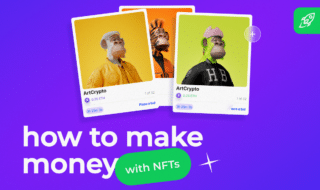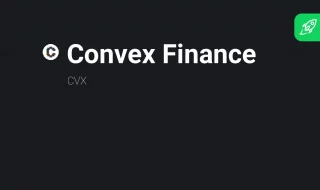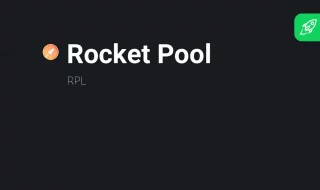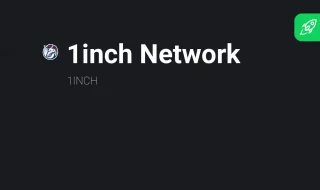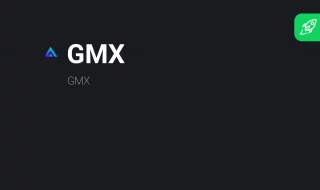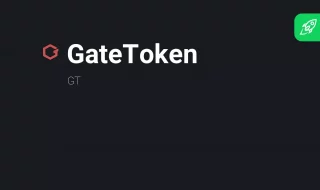Ethereum is the second most famous cryptocurrency in the world. It also holds second place in terms of market capitalization. The interest around ETH and its price keeps on growing, making Ethereum one of the most influential players on the crypto market. Today, we are going to observe the Ethereum platform in detail, explain what Ethereum actually is, who created it, and what impact it has on the community.
Table of Contents
- What Is Ethereum?
- What Is Ether?
- Ethereum’s Founders and History
- How Does Ethereum Work?
- Ethereum: Advantages & Disadvantages
- Pros of Ethereum
- Cons of Ethereum
- Ethereum vs Solana
- How to Get Ethereum
- How to Mine ETH?
- How to Buy ETH?
- FAQ: Everything You Need to Know about Ethereum
- Is Ethereum like Bitcoin? What is Better, Ethereum or Bitcoin?
- Is it good to invest in Ethereum?
- What is an Ethereum Improvement Proposal?
- What is Ethereum crypto used for?
- How long does it take to mine 1 ETH?
What Is Ethereum?
Ethereum is a decentralized platform that enables anyone to build and implement decentralized applications (dApps). The platform is open-source, which means anyone can examine its code, updates, and other details in the GitHub repository. Ethereum is a public chain, so anyone who wants to become an ETH miner can freely join the network. All the transactions made on the blockchain can easily be found in the Ethereum block explorer.
The Ethereum blockchain utilizes the proof-of-work consensus algorithm that requires mining work. Just like the Bitcoin network, Ethereum has miners that sustain a healthy environment within the network, process transactions, and discover new blocks. In return, miners get rewards in ETH cryptocurrency.
However, at the end of 2018, the creator of Ethereum, Vitalik Buterin, introduced the concept of Ethereum 2.0. This updated decentralized platform would show better transaction throughput and become more scalable and efficient in use. Buterin wanted Ethereum to migrate from the PoW algorithm to PoS (Proof-of-Stake) for all the features mentioned earlier to come live. Ethereum 2.0 has a detailed roadmap: the migration of such a great network as the Ethereum platform to a new algorithm will take much time and effort.
Learn more about Ethereum 2.0 here.
After the first phase of Ethereum 2.0’s release in 2020, the complete release is not anticipated until at least 2023.
It was initially expected that Ethereum 2.0 would be launched in 2019, but multiple significant delays occurred throughout its development.
The latest schedule indicates that the Ethereum Merge would occur between September 10 and September 20, 2022.
But let’s get back to Ethereum V1. What makes Ethereum so special?
Ethereum is unique because it is one of the first platforms that allow building and deploying decentralized applications. These applications do not involve any intermediary, thus bringing people together directly.
According to the Ethereum white paper, there are three types of dApps:
- Applications that manage money. A user swaps Ethereum as a method of settling a contract with another user, utilizing distributed computer network nodes to simplify the data distribution.
- Semi-financial applications that offer other functionality apart from monetary operations.
- Other applications, including governmental systems such as voting.
You can create your tokens based on the Ethereum blockchain. These tokens are called ERC-20. ERC (Ethereum Request for Comments) is the official protocol for making proposals to improve the Ethereum network. Twenty (20) is the unique identification number of the proposal. Technical specifications for tokens issued on the Ethereum blockchain were published in 2015. Tokens that meet these specifications are known as ERC-20 tokens. They are smart contracts on the Ethereum blockchain.
What Is Ether?
Ether (ETH) is the native cryptocurrency of the Ethereum blockchain. Being an essential part of the entire network, Ether plays several critical roles.
- ETH is used as a means of payment.
- Ether fuels the whole network. Ethereum miners get paid in ETH so that transactions can be processed, blocks are added to the blockchain, and the network operates flawlessly.
By the way, ETH and over 400 crypto assets can be transferred to your wallet within several minutes. Changelly provides quick access to the world of crypto so that even your grandma can purchase cryptocurrency with a credit card, bank account transfer, or Apple Pay.
Can’t load widgetEthereum’s Founders and History
Anyone involved in the crypto industry probably knows two important names: Satoshi Nakamoto (the creator of Bitcoin) and Vitalik Buterin (the co-founder of the Ethereum platform). In 2013, Vitalik Buterin, a young programmer and a co-founder of Bitcoin Magazine, introduced a white paper where he described a decentralized platform that would allow building blockchain-based applications using a Solidity programming language.
Being involved in the crypto community, Buterin sent Ethereum’s white paper to his friends in order to have it reviewed. Instead, around thirty people contacted him to discuss the concept and the potential of this technology. At the end of 2013, several notable investors, which later would be called “the initial five,” got involved in the Ethereum project. These were Anthony Di Iorio, Charles Hoskinson, Mihai Alisie, Amir Chetrit, and Vitalik Buterin. Three more co-founders joined the Ethereum team at the beginning of 2014. And so, the story of the most influential decentralized platform began.
The formal development of software underlying Ethereum began in early 2014 through the Swiss company Ethereum Switzerland GmbH (EthSuisse). It was founded by a group of developers who were passionate about blockchain technology and saw the potential for Ethereum to change the way the world does business. Since then, the Ethereum project has grown tremendously, with a large and active community of developers and users worldwide. The Ethereum Foundation, a non-profit organization, supports the development of Ethereum and related technologies.
It is impossible to hack the Ethereum blockchain. However, there was a situation that led to a conflict within the community and later to a hard fork.
The scandal around Ethereum occurred in the middle of June 2016. Anonymous malevolent actors withdrew over $60 million from the Decentralized Autonomous Organization (DAO). To fix the situation, there were three options proposed:
- Implement a soft fork and roll back the system
- Make a hard fork and reset smart contracts implemented by attackers
- To not interfere in the process
On July 20, developers, together with the community, chose the second option, and the great Ethereum split occurred. The hard fork helped to return stolen funds to victims, while two separate chains came to life — Ethereum (ETH) and Ethereum Classic (ETC).
Some Ethereum developers, including Vitalik Buterin, Charles Hoskinson, and Gavin Wood, focused on the new chain (Ethereum). Some were against such radical changes as they followed the rule that “code is the law.” These developers and community members stayed on the old (and the original chain) named Ethereum Classic (ETC).
Today, ETC and Ether do not differ that much. Both blockchains keep moving forward by introducing new features and updates.
How Does Ethereum Work?
The Ethereum team created a virtual environment titled Ethereum Virtual Machine (EVM), which allows smart contracts to interact with each other. Within the Ethereum network, nodes start the Ethereum blockchain, and this way, they form EVM. This system is better to be considered as a virtual computer on Ethereum’s blockchain technology, which turns your ideas into code and reproduces it in the global network of Ethereum.
The ERC-20 standard is applied to all tokens. It contains a set of rules for creating coins based on Ethereum. Their observance is necessary for the regular interaction of tokens with the system. Access to blockchain resources is not free.
A transaction fee is measured in units of gas and paid for each operation. For all computational operations, gas has its own fixed rate depending on the complexity. But you need to pay gas in Ethereum, and the user sets the cost of each unit of fuel. The higher the execution price of a smart contract, the higher its priority and processing speed.
The Ethereum ecosystem consists of several essential components:
- Accounts
There are two types of accounts in the Ethereum network:
- externally owned accounts (user accounts or those accounts that require private keys);
- contract accounts or smart contracts. Such accounts are controlled by the code.
- Proof-of-Work (PoW)
Just like Bitcoin, the Ethereum platform utilizes the PoW consensus algorithm to verify transactions. Yet, Ethereum requires less computational power. PoW allows miners to reach a consensus and add new blocks to the chain. However, Ethereum developers are planning to switch the mining algorithm to Proof of Stake.
- Mining
Current Ethereum 1 requires mining and miners. The latter plays a crucial role in blockchain technology. In fact, miners validate transactions and add new blocks to the blockchain. Ethereum miners usually use CPU or GPU to mine ETH. They get rewarded with Ether. Please note that once Ethereum fully migrates to PoS, there will be no miners in the system. The network will be maintained by validators or stakers.
- Blocks
Ethereum miners compete with each other to find the right hash of the next block. Once it is found, the next block is added to the chain while a miner gets a reward. Each block consists of several components, including a header, a nonce, the hash of the previous block, information about transactions, and so on.
- Gas and fees
Users usually complain about high fees within the Ethereum system. Each computation performed on the Ethereum platform is actually a transaction that requires users to pay a fee. Ethereum transaction fees are denominated in gas. When initiating a transaction, a user sets the gas limit and the gas price — the amount of gwei (a unit that a sender wants to pay for the transaction’s execution). The higher the gas price, the faster miners will process the transaction.
- Proof of Stake (PoS)
The Merge, as it’s been named, will see Ethereum move away from its current proof-of-work (PoW) consensus algorithm in favor of PoS, which is seen as a more energy-efficient and environmentally friendly way of reaching consensus.
- Ethereum Smart Contracts
Ethereum was one of the first platforms to offer smart contracts. Back in the glorious Initial Coin Offerings (ICOs) year 2017, the Ethereum network became extremely popular as most of the “top-notch” projects introduced Ethereum-based platforms and issued ERC-20 tokens.
Ethereum: Advantages & Disadvantages
No one is perfect, and just like the rest of the things in the world, Ethereum has its ups and downs. In order to inspect the network from different perspectives, we have gathered Ethereum’s ups and downs.
Pros of Ethereum
Ethereum is the first platform to offer developers a friendly environment and ecosystem for decentralized application deployment. There are toolkits, tutorial videos, and articles with comprehensive instructions on how to build dApps on the Ethereum blockchain. Plus, ethereum.org supports over 30 languages, making access to the platform available for many countries and nationalities.
Ethereum being decentralized gives users their long-awaited freedom and a chance to spread the power among all network participants. There is no central authority that can edit or influence the network in any manner. It is theoretically impossible to hack Ethereum (or any other blockchain technology). Therefore, the Ethereum network is a secure and safe spot for making your crypto ideas a reality.
Cons of Ethereum
Ethereum 1 faces the same challenges as the rest of PoW-based blockchains that require many resources for mining (both electricity expenses and equipment). Running on the PoW algorithm, Ether makes its users pay gas fees that, in times of network overload, can be very high.
Besides, the current Ethereum network is capable of processing around 15 transactions per second (TPS), which is definitely not that much. However, once all the preparation work is done, and Ethereum is fully switched to Ethereum 2.0, all the current disadvantages of the network will be eliminated.
Ethereum vs Solana
Ethereum and Solana are both decentralized platforms that aim to provide a more efficient way of conducting transactions. Both platforms utilize smart contracts, which are self-executing contracts that can be used to facilitate, verify, and enforce the terms of the agreement.
However, there are some key differences between Ethereum and Solana.
- Firstly, Ethereum utilizes a proof-of-work consensus algorithm, which is a computationally intensive process that requires miners to solve complex mathematical problems in order to add new blocks to the blockchain. In contrast, Solana uses a proof-of-stake consensus algorithm, which is less computationally intensive and therefore allows transactions to be processed more quickly.
- Secondly, Ethereum has a block time of 15 seconds, whereas Solana has a block time of just 0.5 seconds. This means that transactions on the Solana network can be confirmed much faster than on the Ethereum network.
- Also, compared to Ethereum, which has far higher transaction fees, Solana is well renowned for its low cost of transactions.
- Next, Ethereum is the second-largest cryptocurrency by market capitalization, while Solana is much smaller and lesser known.
- Finally, Ethereum has the largest network of developers and nodes, as well as the most extensive range of dApps.
How to Get Ethereum
Primarily, there are two ways to get ETH: you can either mine it or buy it on a cryptocurrency exchange.
How to Mine ETH?
If you decide to mine ether, then you have to prepare accordingly. An ETH digital currency’s miner should obtain proper mining equipment, have a secure digital wallet to store ether, and join a trustable mining pool (in case they do not want to mine the cryptocurrency solo).

The hash algorithm used by Ethereum is called Ethash. It hashes the metadata of the last block in the system using a unique code called a nonce (a random binary number that sets the exceptional value of the hash function). For each new block in the blockchain, the network sets a target hash value, and all miners in the system try to guess the nonce value that will lead to such a value.
The underlying cryptographic principles make a random selection of nonce almost impossible. This means that the only way to find the correct nonce is to cycle through the entire range of possible solutions until the correct one is found. In this case, the solution can serve as “proof of work” that the computer detected the correct nonce value and completed the work. In other words, they are using computing power to run the hashing algorithm.
You can learn more about ETH mining in this complete guide.
How to Buy ETH?
If you want to buy Ethereum, you can easily do it on our exchange.
The first step: open the Buy page. Select the pair of fiat currency and crypto you’d like to exchange. In our case, it is ETH and USD. You can also exchange other crypto assets.
Next, enter the amount you are willing to spend to buy the coin in the “You spend” column. The service will automatically calculate the number of coins you will receive in exchange for this amount.
Now, you have to choose the payment offer you like. After that, you need to enter your card details and your crypto wallet address to which your coins will be transferred. If you don’t have a crypto wallet yet, you can open it right away on the same page. Cryptocurrency transactions are irreversible, so please double-check your wallet address before proceeding to the next step.
Finally, you need to confirm the payment. After a few minutes, you will receive your newly purchased cryptocurrency in your wallet. It’s a very quick process, and you can buy ETH while reading this article.
None of the content on Changelly is investment advice, nor is it a replacement of advice from a certified financial planner. Before deciding to buy Ethereum, we recommend you to do your own research.
FAQ: Everything You Need to Know about Ethereum
Is Ethereum like Bitcoin? What is Better, Ethereum or Bitcoin?
Basically, Bitcoin is like a “father” to the rest of the cryptocurrencies. Some projects just take Bitcoin source code in order to create their own blockchain-based cryptocurrencies; some may upgrade the code and create another blockchain and cryptocurrency (like Bitcoin Cash, Litecoin, etc.) Nonetheless, all crypto enthusiasts are inspired by Bitcoin technology. Vitalik Buterin has proven that blockchain and cryptocurrency can be improved and be more than Bitcoin.
Generally speaking, ETH is like BTC — both of them are cryptocurrencies based on blockchain technology. However, the similarities stop here. Bitcoin is a digital currency with a limited supply. There are 21,000,000 BTC in the Bitcoin system, while Ethereum coins can be issued endlessly — ETH’s maximum supply is unlimited.
Ethereum offers multiple ways of technology usage. Due to smart contracts, Ethereum is a giant platform that provides developers with the necessary tools for building decentralized applications.
Is it good to invest in Ethereum?
The future of the second cryptocurrency seems to be bright and promising. Upcoming improvements are going to upgrade not only Ethereum but also the whole blockchain industry: the decentralized finance (DeFi) sector, the gaming industry, the blockchain development sector, and many others. Needless to say, all these upgrades require time and human resources, but it seems that Ethereum is doing great.
These features have led some to believe that Ethereum could potentially disrupt a number of industries, from banking to online communications. Furthermore, Ethereum is backed by a large and growing community of developers, which helps to ensure its long-term viability. As such, Ethereum may be a good investment for those looking to diversify their portfolio or bet on the future of blockchain technology.
If you’re thinking about investing in Ethereum, check out our latest ETH price prediction!
What is an Ethereum Improvement Proposal?
An Ethereum Improvement Proposal, or EIP, is a formal suggestion for improving the Ethereum protocol. These proposals can be related to anything from technical improvements and guidelines to financial incentives and organizational structures. Anyone can submit an EIP, and all suggestions are open to community discussion. Once an EIP has been finalized, it becomes part of the Ethereum roadmap and can be implemented by developers. EIPs have played a vital role in the success of Ethereum so far, and they will continue to be a decisive element of the platform’s future development.
What is Ethereum crypto used for?
Ethereum allows developers to build apps upon its blockchain. These apps can be used to create decentralized markets, execute financial contracts, store data, and much more. As a result, Ethereum has often been referred to as a “world computer” that is able to run apps on a global scale. While Ethereum has a wide range of potential uses, it remains primarily focused on powering decentralized applications.
How long does it take to mine 1 ETH?
The time needed to mine 1 ETH differs and mostly depends on GPU characteristics. For example, if hashing power is 500 MH/s, then it will take around 7.5 days to mine 1 ETH. If your mining rig has the power of 100 MH/s, then it will take about 403 days to mine 1 ETH.
Disclaimer: Please note that the contents of this article are not financial or investing advice. The information provided in this article is the author’s opinion only and should not be considered as offering trading or investing recommendations. We do not make any warranties about the completeness, reliability and accuracy of this information. The cryptocurrency market suffers from high volatility and occasional arbitrary movements. Any investor, trader, or regular crypto users should research multiple viewpoints and be familiar with all local regulations before committing to an investment.











